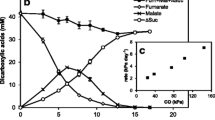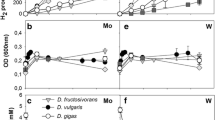Abstract
A free-living aspartate-fermenting Campylobacter spec. was shown to utilize hydrogen produced in mixed culture by Clostridium cochlearium from glutamate. Resting cells of Campylobacter were shown to reduce aspartate, fumarate and malate as well as nitrate, nitrite, hydroxylamine, sulphite, thiosulphate and elemental sulphur with molecular hydrogen. Growth of Campylobacter spec. was demonstrated with formate as electron donor and nitrate, thiosulphate, elemental sulphur or oxygen as electron acceptor in the presence of acetate as carbon source.
Similar content being viewed by others
References
Badziong, W., Thauer, R. K., Zeikus, J. G.: Isolation and characterization of Desulfovibrio growing on hydrogen plus sulphate as the sole energy source. Arch. Microbiol. 116, 41–49 (1978)
Brent, E., Bergmeyer, H. U.: l-Glutamat. Bestimmung mit Glutamat-Dehydrogenase. In: Methoden der enzymatischen Analyse (H. U. Bergmeyer, ed.), 2nd ed., pp. 1659–1664. Weinheim: Verlag Chemie 1970
Buckel, W., Barker, H. A.: Two pathways of glutamate fermentation by anaerobic bacteria. J. Bacteriol. 117, 1248–1260 (1974)
Gottwald, M., Andreesen, J. R., LeGall, J., Ljungdahl, L. G.: Presence of cytochrome and menaquinone in Clostridium formicoaceticum and Clostridium thermoaceticum. J. Bacteriol. 122, 325–328 (1975)
Hatchikian, E. C., LeGall, J.: Evidence for the presence of a b-type cytochrome in the sulfate-reducing bacterium Desulfovibrio gigas and its role in the reduction of fumarate by molecular hydrogen. Biochim. Biophys. Acta 267, 479–484 (1972)
Ianotti, E. L., Kafkewitz, D., Wolin, M. J., Bryant, M. P.: Glucose fermentation products of Ruminococcus albus grown in continuous culture with Vibrio succinogenes: changes caused by interspecies transfer of H2. J. Bacteriol. 114, 1231–1240 (1973)
Inderlied, C. B., Delwiche, E. A.: Nitrate reduction and the growth of Veillonella alcalescens. J. Bacteriol. 114, 1206–1212 (1973)
Laanbroek, H. J., Kingma, W., Veldkamp, H.: Isolation of an aspartate-fermenting, free-living Campylobacter species. FEMS Lett. 1, 99–102 (1977)
Laanbroek, H. J., Lambers, J. T., De Vos, W. M., Veldkamp, H.: l-Aspartate fermentation by a free-living Campylobacter species. Arch. Microbiol. 117, 109–114 (1978)
Macy, J., Kulla, H., Gottschalk, G.: H2-dependent growth of Escherichia coli on l-malate: succinate formation. J. Bacteriol. 125, 423–428 (1976)
Niederman, R. A., Wolin, M. J.: Requirement of succinate for the growth of Vibrio succinogenes. J. Bacteriol. 109, 546–549 (1972)
Scheifinger, C. C., Linchon, B., Wolin, M. J.: H2 production by Selenomonas ruminantium in the absence and presence of methanogenic bacteria. Appl. Microbiol. 29, 480–483 (1975)
Stouthamer, A. H.: Biochemistry and genetics of nitrate reductase in bacteria. In: Advances in microbial physiology, Vol. 14 (A. H. Rose, D. W. Tempest, eds.) pp. 315–375. London-New York-San Francisco: Academic Press 1976
Umbreit, W. W., Burris, R. H., Stauffer, J. F.: Manometric techniques, 4th ed. Burgess 1964
Weimer, P. J., Zeikus, J. G.: Fermentation of cellulose and cellobiose by Clostridium thermocellum in the absence and presence of Methanobacterium thermoautotrophicum. Appl. Environm. Microbiol. 33, 289–297 (1977)
Wolfe, R. S., Pfennig, N.: Reduction of sulfur by Spirillum 5175 and synthrophism with Chlorobium. Appl. Environm. Microbiol. 33, 427–433 (1977)
Wolin, M. J., Wolin, E. A., Jacobs, N. J.: Cytochrome-producing anaerobic vibrio, Vibrio succinogenes SP.N. J. Bacteriol. 81, 911–917 (1961)
Author information
Authors and Affiliations
Rights and permissions
About this article
Cite this article
Laanbroek, H.J., Stal, L.J. & Veldkamp, H. Utilization of hydrogen and formate by Campylobacter spec. under aerobic and anaerobic conditions. Arch. Microbiol. 119, 99–102 (1978). https://doi.org/10.1007/BF00407935
Received:
Issue Date:
DOI: https://doi.org/10.1007/BF00407935




